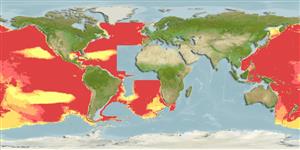>
Lophiiformes (Anglerfishes) >
Gigantactinidae (Whipnose anglers)
Etymology: Gigantactis: Greek, 'gigas' or 'gigantos' = gigantic + Greek, 'aktis' = ray (referring to the unusually long first dorsal-fin spine that functions as a lure in this genus) (Ref. 86949).
Environment: milieu / climate zone / depth range / distribution range
বাস্তুসংস্থান
সামুদ্রিক সমুদ্রবক্ষে ভাসমান (ব্যথিপেলাজিক); গভীরতার পরিসীমা 300 - 5300 m (Ref. 559), usually 700 - 1300 m (Ref. 117245). Deep-water; 68°N - 57°S, 180°W - 180°E
Tropical and temperate parts of all oceans. North-eastern Atlantic: single record at 62°39'N, 33°45'W. Absent from Mediterranean (Ref. 36125).
আকৃতি / ওজন / Age
Maturity: Lm ? range ? - ? cm
Max length : 62.0 cm TL (female)
পৃষ্ঠীয় কাঁটা (মোট ): 0; পৃষ্ঠীয় নরম পাখনা দন্ড (মোট ): 6-7; পায়ূ কাঁটা 0; পায়ূর নরম পাখনা্তুন্ড: 6. Esca covered with minute spines and bearing distally-flattened papillae; elongate, darkly pigmented distal prolongation attached to escal bulb; short, black filaments concentrated around tip of the prolongation; escal bulb with 2-3 unpigmented filaments; close-set pair of small appendages on posterior margin of illicium some distance below bulb (Ref. 13608); length of illicium less than 120% SL (71-112% SL in specimens greater than 25 mm); relatively long dentary teeth (longest 2.6-5.0% SL) in three longitudinal series; length of rays of caudal fin less than 45% SL (Ref. 86949).
Rarely caught (Ref. 559).
Life cycle and mating behavior
পরিপক্কতা | প্রজনন | ডিম ছাড়া | ডিমসমূহ | ডিম্বধারন ক্ষমতা | শুককীট
Bertelsen, E., 1990. Gigantactinidae. p. 513-515. In J. C. Quero, J. C. Hureau, C. Karrer, A. Post and L. Saldanha (eds.) Check-list of the fishes of the eastern tropical Atlantic (CLOFETA). JNICT, Lisbon; SEI, Paris; and UNESCO, Paris. Vol. 1. (Ref. 10761)
IUCN Red List Status (Ref. 130435)
Threat to humans
Harmless
Human uses
আরো তথ্য
প্রচলিত নাম সমূহপ্রতিনাম সমূহবিপাকশিকারী প্রাণী সমূহপরিবেশ বিষাক্ততাবিদ্যাপ্রজনন পরিপক্কতা ডিম ছাড়া ডিমের সংগ্রহ ডিম্বধারন ক্ষমতা ডিমসমূহEgg development
সূত্র সংখ্যা এ্যাকুয়াকালচার (জলজ পালন) এ্যাকুয়াকালচার নকশা বংশ বংশানুগতিবিদ্যাElectrophoresesউতরাধিকার সুত্রে পাওয়া যোগ্যতারোগ প্রক্রিয়াজাতকরণ NutrientsMass conversion
সহযোগী ছবি সমূহStamps, Coins Misc.শব্দ ক্রোমোজোমের ধরণ গতি সাতাঁরের কায়দা ফুলকা এলাকাOtolithsমস্তিস্ক সমূহদৃষ্টি
হাতিয়ার
Special reports
Download XML
ইন্টারনেট সুত্র
Estimates based on models
Preferred temperature (Ref.
123201): 1.9 - 4.7, mean 3.1 °C (based on 4024 cells).
Phylogenetic diversity index (Ref.
82804): PD
50 = 0.5000 [Uniqueness, from 0.5 = low to 2.0 = high].
Bayesian length-weight: a=0.01995 (0.00906 - 0.04395), b=3.01 (2.83 - 3.19), in cm total length, based on all LWR estimates for this body shape (Ref.
93245).
ট্রফিক পর্যায়ে (Ref.
69278): 4.5 ±0.8 se; based on size and trophs of closest relatives
Fishing Vulnerability (Ref.
59153): Moderate vulnerability (45 of 100).
